40-foot Container Dimensions - Complete Guide
Forty-foot shipping containers are huge, multipurpose units that offer an extensive storage capacity. The total cubic capacity of a 40-foot container is about 67 CBM. This amount to you will enjoy a loadable volume of 55-58 CBM.
There are some questions about what exactly loadable volume means and how it differs from shipping container dimensions. Another question is how you calculate the CBM of a 40-foot shipping container. Read on below to find out.
40' Shipping Container Dimensions
For various industries, there are two models of shipping containers that find applications: One of Standard Containers other High-Cube Containers.
Standard Containers
*All standard ISO containers have similar width and height, the only difference revolves around their length. *
In conclusion, ISO-size refers to the container's external length. For example, a 40-foot shipping container signifies that the container itself is 40 feet long.
It's important to note that slight variations in the internal dimensions (width, length, and height) can occur depending on the steel thickness used in the container's construction.
High-Cube Containers
High-cube shipping containers offer increased height compared to standard containers, providing you with the flexibility to accommodate taller cargo.
We've compared the dimensions of 40-foot standard containers and high-cube containers in the following:
Feet and Meters
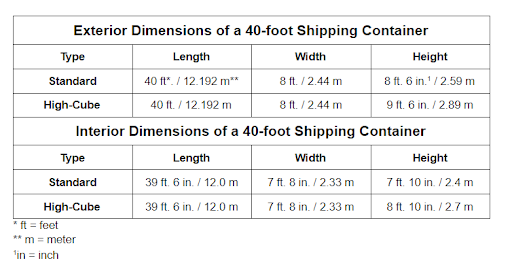
Inches
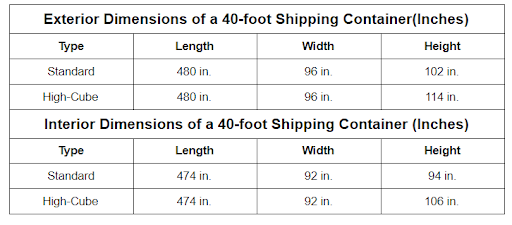
Centimeters and Millimeters
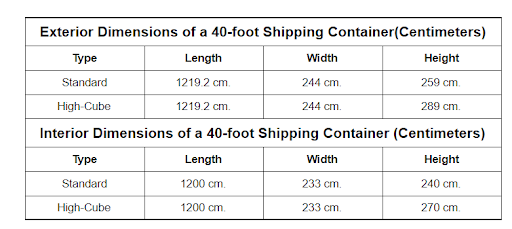
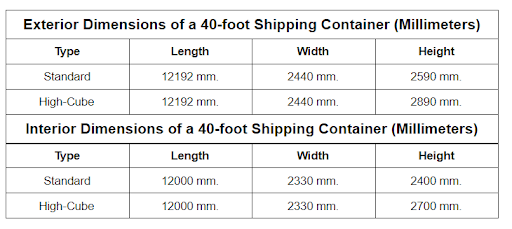
Weight and Volume of 40ft Shipping Containers in Lbs., Kgs., and Tons
When selecting or renting a 40-foot shipping container, two crucial factors to consider are its payload capacity and loadable volume. The container's tare weight represents its own weight, while the payload capacity signifies the maximum weight of cargo it can safely carry.
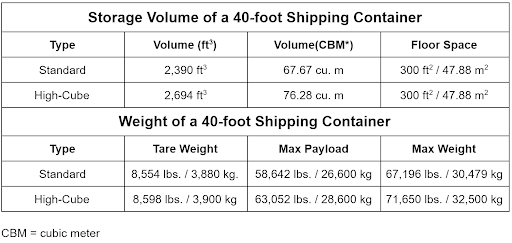
How Much Can I Fit in a 40-foot Standard Container and 40-foot High-Cube Container?
Maximize cargo capacity with high-cube shipping containers. These specially designed units offer increased space for your goods. While they share the same length and width as standard 40-foot containers, high-cube containers boast an extra foot in height, significantly expanding their interior volume.
Since a 40-foot shipping container provides about 67 cubic meters of space, you can load boxes of goods amounting to about 55 - 58 cubic meters of volume.
Likewise, a 40 ft. high cube container with a capacity of 76 cubic meters allows you to load 60-68 cubic meters of cargo. When you stack boxes, you also lose some space depending on the stacking direction.
*The interior space that both these containers offer is ideal for storing multiple cars, heavy machinery, tools and equipment, finished goods, and even personal belongings while moving. *
How Many Pallets Can Fit into 40 ft. Containers?
About 18 pallets (220 cm tall) or 36 pallets (110 cm tall) can fit inside the container. The American-standard pallets measure 1 m x 1.2 m, while Euro pallets are 0.8 m x 1.2 m in size.
Moreover, a 40 ft. container helps you store 20-21 American pallets and 23-24 Euro pallets. High cubes have about 9 CBM extra volume; also, if you're vertically stacking cargo in a 40 ft. high cube, you can fit more pallets.
But, the storage capacity of a steel container also depends on the loading configuration, nature of goods, transport distance, and ease of access.
How Many CBM is a 40-foot Shipping Container?
CBM, short for cubic meters, is the standard unit used to measure the cargo capacity of shipping containers.We will some tricks about how you can calculate the CBM:
- Measure the internal width, length, and height of the container.
- Convert these dimensions into meters, if necessary.
- Use the formula, Volume (CBM) = Internal (Length x Width x Height)
What Types of 40-foot Shipping Containers Can I Purchase?
40-foot containers offer a robust solution for the safe and reliable international transportation of cargoes. Their wind and waterproof design protect your goods during long journeys and makes them perfect for intercontinental transportation. You have options when it comes to acquiring these containers:
One-trip containers: These containers are one-time only. They are in almost new condition but are usually more expensive than used ones.
Used containers: Used containers offer a more budget-friendly alternative, but their condition can vary depending on previous use.
Double-Doors
This type of container has two openings to help you load and unload heavy loads quickly.
Flat Rack Container
Flat rack containers or flat racks do not have side doors and walls. Thus, you can conveniently mount the containers from the top and side, making them the perfect solution for the transportation of heavy goods and oversized products.
Vented Containers
Ventilated containers have a unique structure that prevents condensation and moisture build-up. This makes the containers perfect for the transportation of goods that are potentially affected by moisture.
Conclusion
As a result, the 40 ft. container is one of the most efficient solutions for storing oversized goods. By determining the dimensions and storage capacity of the container, 40 ft. containers help you decide if the container meets your application.
If you would like to contact us, you can reach us at +90 216 404 11 33 or send an e-mail to info@biggbrandsb2b.com.















































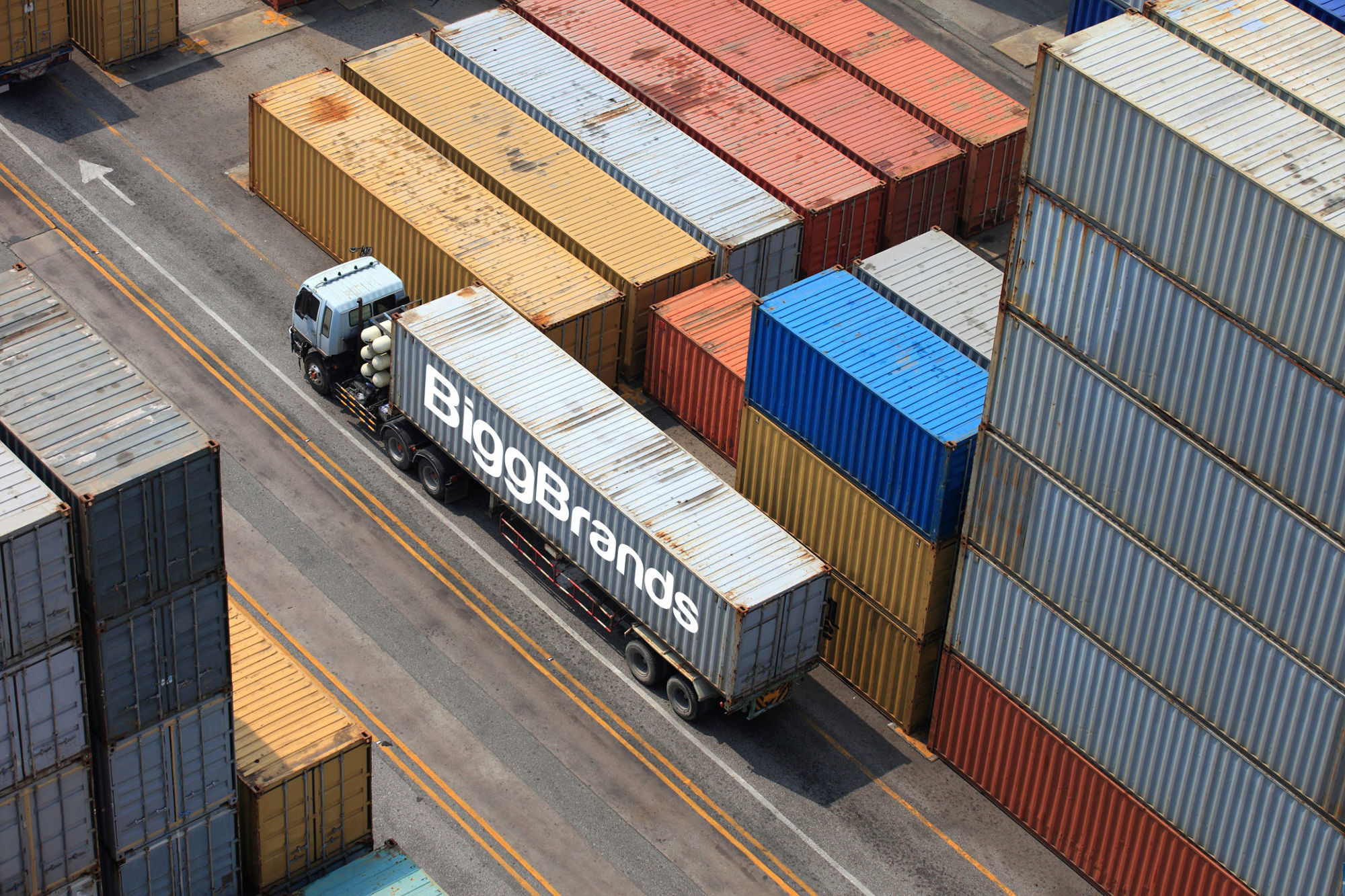
 TURKEY HQ
TURKEY HQ MEA OFFICE
MEA OFFICE NETHERLANDS OFFICE
NETHERLANDS OFFICE GERMANY OFFICE
GERMANY OFFICE USA OFFICE
USA OFFICE SAUDI ARABIA OFFICE
SAUDI ARABIA OFFICE









